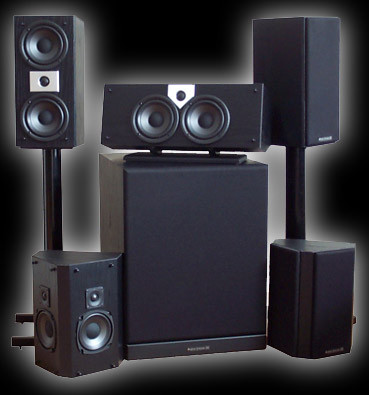Product Review - Atlantic Technology 270THX
Select Series Home Theater Speaker System - April, 2000
Brian Florian
![]()
|
Atlantic Technology 270THX Select Series Home Theater Speaker System 271LR: 2-way Sealed box, Two 5-1/4" IMG Woofers. One 1" Silk Dome Tweeter, 80 Hz - 20 kHz � 3 dB. 8 Ohm. $699 / pair USA 273MC: 2-way Sealed box, Two 5-1/4" IMG Woofers. One 1" Silk Dome Tweeter, 80 Hz - 20 kHz � 3 dB. 8 Ohm. $549 USA 274T-SR: 2-way Frequency Enhanced Di-Pole. Two 4-1/2" IMG Woofers. Two 3/4" Silk Dome Tweeters, 80 Hz - 20 kHz � 3 dB. 8 Ohm. $649 / pair USA 272PBM: Sealed-Box Powered Subwoofer. One 12" Driver, 225 Watt Amplifier. $899 USA |
| Atlantic Technology, 343 Vanderbilt Avenue, Northwood, Massachusetts 02062; Phone 781-762-6300; Fax 781-762-6868; E-Mail Web http://www.atlantictechnology.com |
Introduction
 As this is our very first
look at speakers from Atlantic Technology (AT), a little background on their design philosophy
is in order. Started in 1989, Atlantic Technology began like so many
other speaker companies, with an idea about how to do multi-channel speaker sets
"right". That pretty much was, and still is the idea: Make "sets" of speakers which
are designed to work together and complement each other in a multi channel environment.
As this is our very first
look at speakers from Atlantic Technology (AT), a little background on their design philosophy
is in order. Started in 1989, Atlantic Technology began like so many
other speaker companies, with an idea about how to do multi-channel speaker sets
"right". That pretty much was, and still is the idea: Make "sets" of speakers which
are designed to work together and complement each other in a multi channel environment.
Put another way, what Atlantic Technology doesn't do is make a whole slew of speakers and then prompt the customer to mix and match to create a 5.1 speaker array. Rather, they design each of their speaker systems as a 5.1 whole, with mains that are mains, centers which are centers, and surrounds which are (you guessed it) surrounds. Though you can buy the pieces individually, they are intended to work together. AT is not the only company to take this approach, but it explains allot of their design philosophy.
The result of this philosophy is having main and center speakers that make no pretence about their curtailed low end response: There is supposed to be an associated subwoofer in the room with them. This allows the designers to maximize the performance of the bandwidth that the speaker does produce. Along a similar vein, all of AT's surround speakers are dipolar.
The present review is on their 270THX speaker system, gilded with THX Select status. Colin Miller gave a brief description of THX Select speaker principles in an earlier review. I need not expand on his description of the standard, save to clarify one point: While that ensemble used a monopole configuration for its surround speakers, one should not infer that THX Select dropped the preference for dipolar surrounds. Rather, monopoles are permitted in the Select spec because (a) many small rooms for which Select was intended make dipoles dysfunctional, and (b) they make for a less costly option (dipoles have twice as many driver elements, with an associated price).
Suggested list of the 5.1 ensemble, US$2,796.
271LR Left and Right Speakers
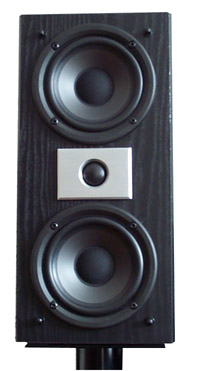 A casual glance at the 271LR
speakers would hold them as not at all unique, and in many ways this is true. The
basic design is a common vertical d'Apolito array with a single tweeter sandwiched between
two woofers, one above and one beneath. On closer examination though, one notes
that, unlike the majority of the speakers today, these are not ported designs, but the
less common sealed, acoustic suspension. As a vary loose generalization, porting a
design yields a low-end roll-off which begins lower, but then rolls off at an alarming
rate. Sealed enclosures on the other hand, while starting their roll-off higher, do
so at a much shallower rate. Again these are generalizations, but the point is, the
271LR was not designed to reach deep down to begin with, and is ideally implemented in a
system with the THX crossover.
A casual glance at the 271LR
speakers would hold them as not at all unique, and in many ways this is true. The
basic design is a common vertical d'Apolito array with a single tweeter sandwiched between
two woofers, one above and one beneath. On closer examination though, one notes
that, unlike the majority of the speakers today, these are not ported designs, but the
less common sealed, acoustic suspension. As a vary loose generalization, porting a
design yields a low-end roll-off which begins lower, but then rolls off at an alarming
rate. Sealed enclosures on the other hand, while starting their roll-off higher, do
so at a much shallower rate. Again these are generalizations, but the point is, the
271LR was not designed to reach deep down to begin with, and is ideally implemented in a
system with the THX crossover.
Atlantic Technology does not make speaker drivers from scratch, relying instead on critical and scrupulous selection from the OEM market. To their credit, the drivers in the 270 series demonstrate some excellent qualities: The woofers are of injection molded graphite, the suspension is made from long lasting rubber, and the magnets are generous for the size of the driver. At this price I would have expected to see cast frames, but the stamped steel obviously did not hinder THX's approval. The cloth dome tweeter assembly is based on a machined aluminum face plate, 4mm thick.
While the cabinets are a straightforward construction of thick (16mm) MDF, I found the vinyl finish a little wanting. A sensible set of gold plated binding posts make up the connections, and there are key-hole type sockets for wall mounting.
273MC Center Channel
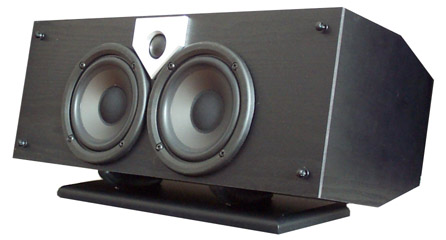 I am somewhat amused by a good portion of the people who are against
dipole surround speakers: They proclaim that multi-channel truth can only be rendered by
five identical speakers. Yet virtually none of these proponents employ a center channel that is identical to their other
four main speakers. The closest most come is a horizontal d'Apolito design which gets a
chesty reinforcement from the face of the TV screen and usually has some off-axis
comb filtering. The 273MC pro-actively addresses the reality that it is in fact a different speaker and that
its placement will affect its sound differently from the mains.
I am somewhat amused by a good portion of the people who are against
dipole surround speakers: They proclaim that multi-channel truth can only be rendered by
five identical speakers. Yet virtually none of these proponents employ a center channel that is identical to their other
four main speakers. The closest most come is a horizontal d'Apolito design which gets a
chesty reinforcement from the face of the TV screen and usually has some off-axis
comb filtering. The 273MC pro-actively addresses the reality that it is in fact a different speaker and that
its placement will affect its sound differently from the mains.
Conscientiously I must note that when the 270 series was first reveled, the 273MC was in the ubiquitous horizontal d'Apolito. But by the time the THX badge made its way to the grille, the driver arrangement was revised ever so slightly. From the picture you can see the two woofers have been brought as close together as possible with the tweeter nuzzled in there as well. This simple adjustment creates more of a point source, the likes of which many center speakers only dream of. The speaker's design includes the pictured "plinth" which permits the speaker to easily tilt up or down to point the drivers right at the audience, whether it be placed above or below the display device.
On the back of the enclosure are a few unique controls, the first of which is a "boundary compensation" switch. Long story short: When engaged, a dip is created in the upper mid-bass to counteract the boost that the same region gets from the TV face. After experimenting, I elected to use this feature.
The other switch on the back is labeled "dialogue enhancement". When engaged, a boost is provided in the mid range to improve dialogue intelligibility in rooms which absorb too much of that frequency band (be it drapes, plush couches or what have you). This one I did not like so much and left it off.
Lastly, the 273MC has a high frequency control which is synonymous with a treble knob, not unlike the one already on your receiver. It is there for you to tone down those brash, bright, brittle soundtracks. While most of the time I left this in the default ("flat") position, I found it productive to take it down a bit for some of those old mono movies whose soundtracks have compromised fidelity.
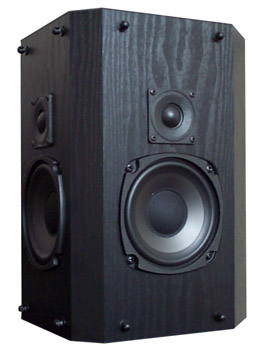 274T-SR Surround Speaker
274T-SR Surround Speaker
As already noted, Atlantic Technology, like THX, believes firmly in the axiom that dipoles are the only way to go for surround speakers. The philosophy is quite reasonable: Soundtracks are assembled, or I like to use the word crafted, for playback over the equipment configuration found in cinemas. For the surround channels, this means arrays of 8 to 12 speakers on each side, which produce quite a different sound than would be voiced by a single unit. The sound artist therefore mixes and weaves the sound elements to sound 'correct' over these arrays. Simply stated: Dipole speakers are the most practical way to emulate the 'sound' of a speaker array within the confines of a home theater environment. 'Nuf said.
The 274-SRs have slightly different (read smaller) drivers than the front three, arranged on two baffles which are at a 900 angle to each other. Like all the main speakers, they are relatively small, and the interior decorator in the family will not have too much trouble accepting them in their proper position: to the left and right of the seating area, about 2 feet from the ceiling. Key-hole sockets are provided to facilitate wall mounting.
272PBM Subwoofer
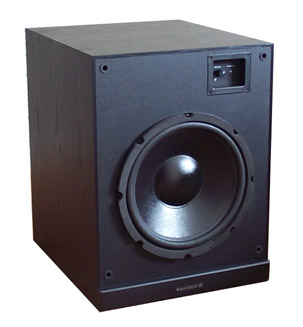 The 272PBM subwoofer is proportional to the
rest of the set in that it's not an enormous unit. In fact, it favors a
little height in order to take up less floor space: a welcome trait in a cramped
room. Further, it is magnetically shielded, which let me put it in one of the best
subwoofer positions in my room (as dictated by physics), i.e., directly beside the TV.
The 272PBM subwoofer is proportional to the
rest of the set in that it's not an enormous unit. In fact, it favors a
little height in order to take up less floor space: a welcome trait in a cramped
room. Further, it is magnetically shielded, which let me put it in one of the best
subwoofer positions in my room (as dictated by physics), i.e., directly beside the TV.
It is a sealed enclosure, rare in today's subwoofer market. In the listening notes, we'll discuss the performance of this design.
Atlantic Technology quotes the 272PBM as having a 225 watt amplifier (though like most all manufacturers, few parameters are given). Basic speaker level inputs are provided, as are the requisite line level. In addition, there is a set of high-passed outputs and unfiltered outputs, handy if you want to daisy chain several units together. A fixed (choice of 00 or 1800) phase switch is provided, as well as an always-on switch which defeats the default auto-on feature. The sub's own low pass is rather limited in that it is not variable, offering only 4 set values (50, 80, 100, and 140 Hz). The intention here, I suppose, is that more than likely, you will just defeat the low pass and use the crossover in your surround decoder.
Nice touch: The level/volume control is on the front of the unit, but will normally be concealed by the grille. There is also an amber/green status light, visible through the grill, but can at your option be covered simply by rotating the orientation of the grill.
Listening: The sum of the parts
In the beginning, I found the overall sound sound bland and banal. I even wondered what I was going to write about them. Call it break in, call it getting used to a new speaker, call it whatever you want, but a couple weeks later I grew to really like what I was hearing. All of the main speakers present a sound which I describe as decidedly relaxed. This is not necessarily a negative but starch audiophiles may not find the sound analytical enough for their definition of sonic truth. Yet, if you are one of many who are tired of speakers that try to pass off brightness as detail, you may find this laid back nature a welcome respite for your ears. Detail is still quite good, perhaps more real than many of today's harsh speakers, and the midrange is mild and neutral. The LR pair, when run in two channel, image like the dickens, something we've come to expect from vertical d'Apolitos. Their soundstage is wide, easily transcending the physical position of the boxes. The center in particular gets a nod for delivering appreciably intelligible dialogue.
The surrounds, as we expect from dipoles, presented a delicious sense of envelopment, with almost no indication of their physical location, yet achieve seamless splicing to the front as sounds pan around.
The most common characteristic associated with anything THX is the word "loud". The system 270 is genuinely capable of reference level playback in the 1500 ft3 room we tested it in. The 270 hammered out the high SPLs without any strain at all. It was almost as if the system sounded better as we pushed the level up.
The subwoofer for me was the real surprise. Its performance in the size of room for which it was intended belies its relatively slight presence and medium sized driver (in an age when only 15" and 18" drivers are being called "big"). Its in room response was as flat as one could ask for, with the gentle roll-off for which the sealed enclosure is known. Even through the normally bumpy 30 Hz - 40 Hz area, the 272 felt rather linear. This affords the 272 a latent presence: felt but not heard as it played the nether regions of select soundtracks. Not only can it pound, but it is also able to satisfy musically, something that is tricky for many subs. Though we were able to get useful output through most of the 20s, by the time 23 Hz came by on the sine-sweep, the PBM272 had lost its presence, though output is still realized at 20 Hz. This is rather good performance for a 12" cone and more than adequate for most soundtracks. The 272 does not get noisy as it reaches down. Ported enclosures can sometimes conjure up all sorts of curious coloration as they reach the bottom, the driver eventually flapping vainly in open air. At particularly 'enthusiastic' playback levels, there is some coloration but nothing out of line for its size or price point. After getting to know the 272, I think I may just become an advocate for the sealed, acoustic suspension subwoofer design.
Ironically, the 272 is the first sub I've come across who's upper bass performance I feel I must comment on. It seemed too adept at voicing sounds above its normal operating range, and I found the crossover in my Yamaha not sharp enough: it was necessary to cascade it with the subs own low-pass before its direction would not be detectable. Unfortunately (for me at least), the auto on/off circuit, though adequately sensitive, was too quick to turn itself off. If a quiet scene in a movie lasted more than a minute or two, the sub would turn off with a click, and then back on again as soon as a strong signal returned. The subwoofer output level of a THX processor or receiver is generally much higher than typical consumer equipment, so this may be a moot point in that situation.
Conclusion
More credit I think is due the engineers at Atlantic Technology than due the speakers themselves. The company has successfully weaved ordinary materials and designs into an ensemble which obviously performs to the level and with the characteristics demanded by the THX Select standard. Though somewhat flexible, the set is ideally paired with a THX Select receiver or processor/amplifier combination. This will give the system the crossover for which it was designed, and feed the subwoofer the signal level it was optimized for. The very relaxed nature of the system will make it very appealing for many a movie enthusiast.
This is not to say they are in some way deficient in playing music material - I rather enjoyed them in the role - but there is simply more "taste" factor in music reproduction. Regardless, the system is capable of prodigious output (amplifier permitting) without any compromise to character. The subwoofer gets particular approval for terrific deep bass performance in the size of room for which it was intended.
- Brian Florian -
Related Hardware:
Yamaha RX-V795a Processor/Receiver
Rotel RB-985 5 channel THX amplifier
Toshiba 2108 DVD player
Yamaha CDC-695 CD player
Nordost Blue Heaven, Moonglow, and S-Optix cable
Sony KV-27S36 Trinitron TV
![]()
� Copyright 2001 Secrets of Home Theater & High Fidelity
Return to Table of Contents for this Issue.

